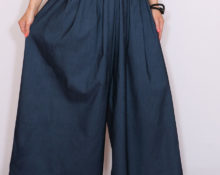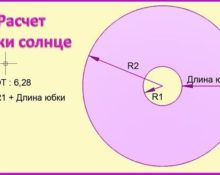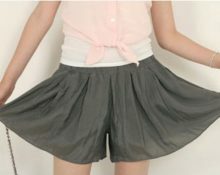 A skirt can transform any outfit, creating a combination that is both feminine and stylish. One of the most popular styles is the half-sun skirt. It is particularly romantic and versatile: this model is suitable for any occasion and for a girl with any type of figure. The big advantage of such a product is that it is easy to sew it yourself. To do this, you need to take measurements, carry out the calculations correctly and build a pattern.
A skirt can transform any outfit, creating a combination that is both feminine and stylish. One of the most popular styles is the half-sun skirt. It is particularly romantic and versatile: this model is suitable for any occasion and for a girl with any type of figure. The big advantage of such a product is that it is easy to sew it yourself. To do this, you need to take measurements, carry out the calculations correctly and build a pattern.
Preparing the pattern
The initial stage is the competent construction of the pattern. The final result of the work depends on the accuracy of calculations and correctness of actions. The process should be approached with special care and patience. Despite the fact that the half-sun is one of the simplest styles, if done incorrectly, it is quite easy to ruin the finished version.
Materials

To build a drawing you need to prepare the following:
- sewing meter;
- pencil;
- piece of chalk;
- whatman;
- ruler;
- scissors
- sewing material.
Required measurements
When starting work, first of all take the necessary measurements. For this you will need a sewing meter. We measure waist circumference, hip circumference And required length. It is recommended to write down the taken indicators. This will help you remember the accuracy of your measurements.
Calculations for patterns
Calculation of small and large radii is the most difficult stage in the entire work process. Let's start counting.

The small radius is calculated using a special formula: K*measurement of waist circumference. Label TO is the coefficient of curvature of the upper cut of the product. For a half-sun skirt it is 0.32 cm.
If the finished product will have an elastic band, you should increase the waist measurements by 1/4, and then make calculations.

To calculate the radius of the bottom, you will need indicators of the length and waist area. The wider the radius, the more voluminous the skirt will be.
Construction of a drawing
Now you can start building the pattern.

- Using a long ruler and pencil, draw a right angle on whatman paper. We mark the top with a letter (for example, “A”).
- From her put a straight line on top, which is equal to the length of the product. Don't forget to leave 1-2 centimeters for allowance on each side. They are spent on seams.
- The next step is bottom line. In accordance with the large radius indicators, we make a cone-shaped line, stopping it under the “A” mark.
- Let's move on to the other half of the seam. From point “A” downwards we lay a line identical to the length dimensions.
- The final stage is the small radius - the waist area. From the top of “A” we set aside a measurement that corresponds to the parameters of the waist line radius. Draw an arc connecting both halves.
The pattern is ready.
Reference: The increase in waist size can be increased at your own discretion.The more centimeters you add, the more folds you will get on the finished product.
Their depth also depends on the frequency of folds.
After the work has been done on paper, we cut out the pattern and transfer it to the fabric. At the initial stage, it is recommended to build patterns on paper. In the absence of the necessary experience and skills, this will help to significantly save fabric consumption.
Pattern options

- This pattern is suitable for a skirt with one seamless seam. The stitching can be placed on the sides or on the back.
- When making a pattern for sewing products with two side seams Similar recommendations should be used. The difference is the process of cutting materials before sewing. From the top of the right angle, a midline is drawn in the center, which divides the product into two parts.
- When creating a pattern for a skirt with a yoke, you can use an example for a straight standard product. Build the skirt itself in accordance with the rules described above.
Advice: If, when sewing, a stitch located along an oblique line is used, you must carefully observe the angle of the center of the parts.
It should be 45 degrees, no more. Otherwise, during use, the skirt may begin to slip and roll to one side.
Correct calculation of fabric consumption
The main issue when preparing to sew a product is the necessary fabric consumption. If there is a lack of material, you may encounter significant difficulties. The main problem will be the wrong pattern, which will have to be redone or the sewing process will have to be abandoned altogether. Let's figure out how much fabric is needed for a skirt.

When using the method with two lines on an elastic band, you will need material the consumption of which is equal to two half-skirts.That is, 2 lengths and 2 radii.
The calculation is made according to the following formula: 2x(R1+DI)+10 cm. 2 is allocated for allowances for laying seams, R1 is the final indicators of the small radius, DI is the length of the product. It is recommended to take all measurements in advance, write down the indicators, and then go to a specialized studio to purchase materials. This will help to avoid force majeure circumstances.
Attention: the sum of the radius and length of the skirt should not exceed the width of the material itself.
When choosing a material with an ornament or checkered pattern, it is necessary to build patterns in accordance with the location of the pattern. This will require cutting out two parts, the sides of which will coincide in the ratio of patterns or lines. In this case, the material consumption should be significantly increased without using standard examples for calculations.
Skirts occupy a significant part of every fashionista's wardrobe. There are sure to be several items in your closet that are suitable for any occasion and ensemble. One of the most stylish, versatile and smart additions will be a semi-sun skirt. With the right approach, taking up patterns and sewing yourself will not be difficult. Such a product will be a harmonious addition to any wardrobe and will help its owner stand out from the crowd.


 0
0





